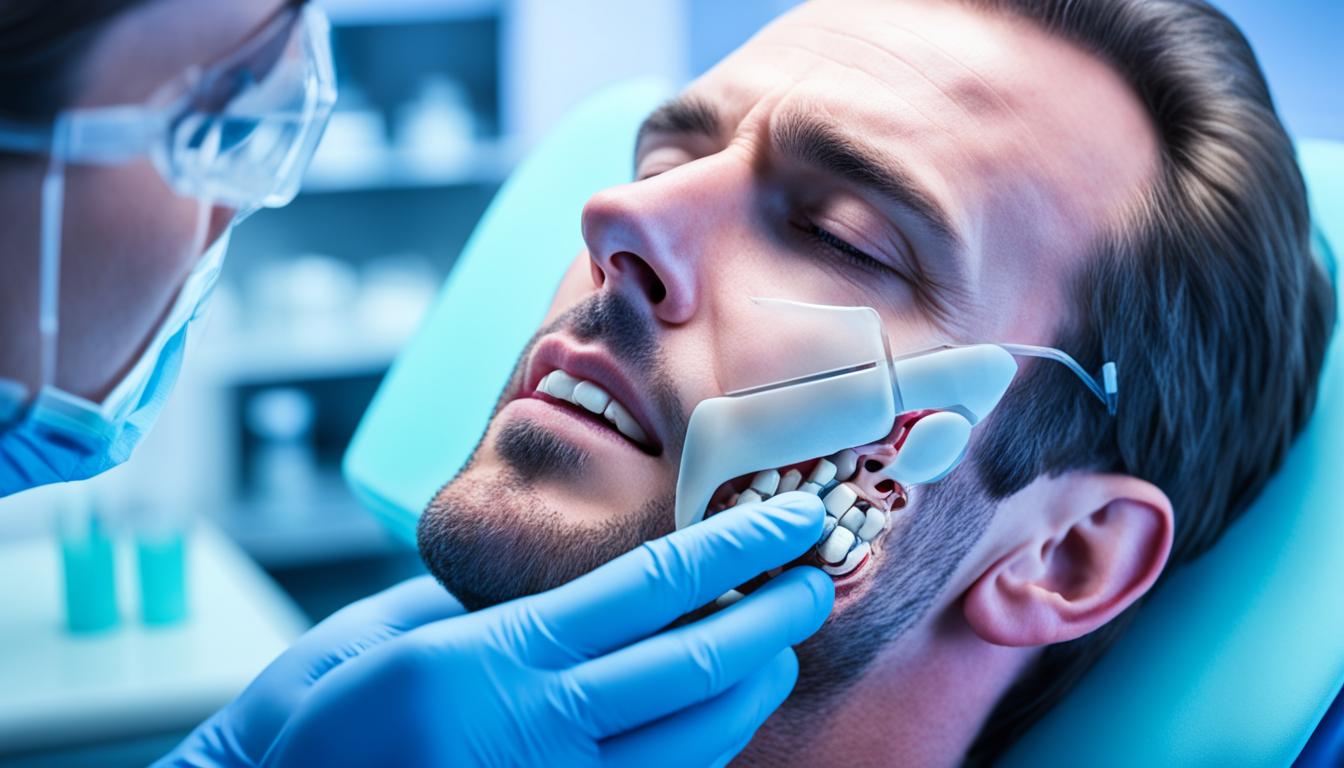TMD stands for temporomandibular joint disorder. It’s a problem that affects the jaw joint, causing pain and other issues. Common symptoms include jaw pain, a clicking or popping sound, and trouble moving the jaw. The exact causes of TMD are not completely clear, but it might come from genetics, jaw injuries, or problems with dental health.
Diagnosing TMD usually starts with a check-up by a doctor or dentist. They might also use tests like X-rays and ask about your medical history. Treating TMD can require physical therapy, medicines, or more advanced methods, like stem cell therapy. Stem cell therapy involves using special cells from a patient’s bone marrow to help the jaw joint heal. This treatment aims to reduce TMD symptoms and make the jaw work better.
Key Takeaways:
- TMD, or temporomandibular joint disorder, is a degenerative musculoskeletal disorder that affects the jaw joint.
- Common TMD symptoms include jaw pain, clicking or popping sounds, limited jaw movement, and facial pain.
- The exact cause of TMD is not fully understood, but it is believed to be a combination of factors.
- Diagnosing TMD involves a physical examination, imaging tests, and evaluating the patient’s medical history.
- Treatment options for TMD include physical therapy, medications, and stem cell therapy for tissue regeneration.
Symptoms of TMD
If you’re feeling jaw pain or hearing clicks when you move your mouth, you might have TMD. TMD stands for temporomandibular joint disorder. This condition shows up in different ways for different people.
- Jaw pain
- Clicking or popping sounds when opening or closing the mouth
- Limited jaw movement
- Facial pain
- Headaches
- Earaches
- Muscle tenderness
- Tooth sensitivity
These signs can really change your life. They can make eating, talking, or yawning hard. It’s key to see a TMJ specialist for the right diagnosis and treatment.
Causes and Risk Factors of TMD
Temporomandibular joint disorder (TMD) comes from various causes. It brings jaw pain and other TMJ symptoms. Knowing these causes helps manage and prevent problems.
Jaw Clenching and Teeth Grinding
The first cause is often jaw clenching or teeth grinding, called bruxism in medical terms. These actions put too much pressure on the TMJ. This causes dysfunction and TMD symptoms. Lifestyle changes, stress relief, and dental devices can ease TMD.
Dental Issues
Problems like a bad bite, lost teeth, and wrong dental work can also cause TMD. A bad bite can make forces unbalanced when you move your jaw. This leads to TMJ problems. Lost teeth or bad dental work can also mess with how your jaw works, upping TMD risk. Fixing these dental issues with orthodontics and dental devices can cut TMD risk.
Other Risk Factors
Besides jaw clenching and dental troubles, other things can bring on TMD. An injury to the jaw, like a dislocation, can lead to TMD. So can arthritis, like osteoarthritis or rheumatoid arthritis, affecting the TMJ. Hormone changes, often in women, and high stress levels can start or worsen TMD too. Working to avoid or deal with these factors is key for TMD control.
To prevent TMD, it’s key to tackle its causes and risks. Good oral health, prompt dental care, stress control, and preventing jaw-clenching or teeth grinding are important. This can protect your jaw health and keep TMD away.
Stem Cell Therapy for TMD
Stem cell therapy is new and exciting for treating temporomandibular joint disorder (TMD). It uses stem cells from your own bone marrow to heal the TMJ. This method can repair the joint and ease TMD symptoms, making the jaw work better.
It’s a great option for those not helped by usual treatments. Stem cell therapy is safe and helpful, using your body’s healing power. Yet, more studies are needed to be sure how well it works in the long run.
For anyone struggling with TMJ issues, stem cell therapy shows a lot of hope. It can help repair your joint and reduce TMD pain. As science progresses, this therapy could change how we treat TMD, making life better for many.

